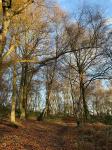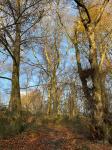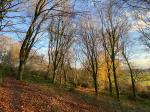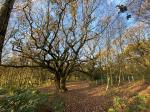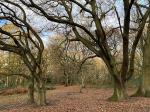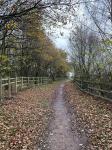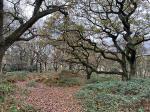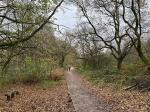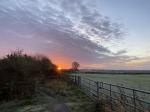Brayton Barff Through the Seasons.
Set in the Vale of York, South West of the market town of Selby and between the villages of Thorpe Willoughby and Brayton, lies Brayton Barff, a sandstone Hill approximately one hundred and fifty feet in height which was formed by glacial movement during the last Ice Age. It is a significant landmark in an otherwise flat landscape.
Today the site is primarily owned by Yorkshire Water with Selby District Council owning a small patch of the land adjacent to the A63 Selby bypass. A large underground reservoir occupies the centre of the site which delivers water to around 4.7 million customers throughout Yorkshire.
Within the Barff woodland over 40% of the trees are Sessile Oak which are generally found in semi natural woodlands in the north of the country. These trees are so called because its acorns are not held on stalks, like those of the English Oak (Pedunculate), but attached directly to the outer twigs. There are also several English Oak trees as well as some cross-hybrid oaks. These trees are known to support many species of flora and fauna, invertebrates, mosses, lichen and fungi.
During the Victorian times it is thought that the shipbuilders on the east coast would come over to the Barff for selected cuts of timber to build their sea going vessels.
The Barff also has a variety of other trees including Silver Birch, Beech, Sycamore, Holly, Rowan, Scots Pine, Alder, Hawthorne and European Larch. There are also several Yew, Willow, Hazel, Horse Chestnut and Wych Elm. As with similar woodlands there are a variety of bushes, including Honeysuckle, Elderberry, Gorse, Broom and Buddleia.
The history of Brayton Barff is quite vague, apparently during 1803 a beacon was lit on the Barff when the country was threatened with an invasion by Napoleon. In May 1935, to celebrate King George V's Silver Jubilee, a Bonfire was lit on the Barff as part of the celebrations.
Early issues of Ordnance Survey Maps dated 1903 clearly show a rifle range on the Barff, extending out to Mill Lane. During the 
Between 2001 – 2004 the A63 Selby bypass, 10km twin lane single carriageway was constructed which severed the South West corner of the Barff, adjacent to Selby Golf Course and resulted in a slight redesign of several holes on the golf course. Wooden fencing was erected as a result of this new road running alongside of the Barff and a footbridge constructed over the ‘new road’ following the line of the Bridal way which extends from Mill Lane. Around 2005/2006 a definite 2metre wide limestone aggregate footpath was laid forming a circular path around the outer edges of the woodland. This footpath is approximately 1.2 miles in length and takes about 30 minutes to circumnavigate at a leisurely pace.
In 2012 the Barff was declared an Ancient Oak Woodland and as such throughout 2012 and 2013 significant work had been carried out by the relevant agencies to cut and remove large swathes of non-native trees, creating at that time huge scars on the landscape. Some three years later the planting of the native trees have become well established and are flourishing. Ongoing maintenance work on the footpath around the bottom of the Barff was completed during the Summer of 2016.
A second phase of woodland maintenance commenced during the Autumn of 2019 with the removal of many old and diseased trees and the cutting back of the Gorse and Broom bushes, especially adjacent to the ‘bypass trail’, this work continued through till March 2020 with re planting continuing into April 2020.
Brayton Barff is a popular site for walkers and bird watchers alike and a path circling the outer perimeter of the Barff makes a pleasant thirty minute walk, giving views looking over towards Selby and the village of Brayton as well as the power stations of Drax and Eggborough..jpg)
For the early risers it is a great place to see some stunning sunrises over the villages of Brayton looking towards Drax Power Station, the same with the Sunsets looking over towards Eggborough and Monk Fryston.
The Barff changes with the Seasons and every visit can reveal something new, the woodland is a haven for wildlife. Records show that since 1982 one hundred and twelve species of bird have been seen in the woodland and at least 40 of those have bred here, including Tawny Owl, Buzzard, Green Woodpecker, Spotted Flycatcher, Goldcrest and Nuthatch to name just a few. On average over 70 species of bird are recorded each year. Further details of the bird life on the Barff can be found on the Brayton Barff Group Facebook page, especially the posts from Derek Cooper. Today ‘The Friends of Brayton Barff group’ led by Derek and a small team of volunteers help keep and maintain the cleanliness of the site as well as recording the wildlife and bird sightings.
The Barff is also home to fifteen different species of mammals, including Muntjac Deer, Pipistrelle Bat, Fox, and Field Vole.
Over eighty species of plant and wildflowers have been recorded, included Bee Orchid, Northern Marsh Orchid, Wood Anemone, Marsh Ragwort, Bluebell, White Bluebell, Bittersweet and Purple and White Foxgloves. Over twenty species of Butterfly have been recorded, including Marbled White, Brown Angus, Speckled Wood, Comma and Brimstone.
During the Autumnal months fungi thrives in this woodland environment, species including Fly Agaric, Beefsteak Tree Fungi, Chicken of the Wood, Sulphur Tufts, Stinkhorn, Ink cap, Puffballs and Hoof Bracket are just some of the many varieties that can be found here.
Click on the galleries shown below to expand the albums.
December 2021
As the year draws to a close, the days have become considerably shorter too, with the sun rising after 8 o’clock in the morning, and by 4 o’clock in the afternoon it is dark.
My lasting memories of December on the Barff this year are that of some very wet and muddy morning dog walks and several amazing sunrises. Although it has been exceptionally muddy underfoot, the weather has been quite pleasant for this time of year. We have had one or two overnight frosts and a lot of overnight rain but that said the last two days of the month were possibly the warmest on record when the morning (8.00am) temperature hit 13C on the 30th and 31st respectively.
This unseasonal weather is certainly confusing many of the birds on the Barff, I have heard and watched on several mornings a pair of Great Spotted Woodpeckers busily drumming away on some of the rotten trees, I’ve also heard the distinctive call of a Great Tit most mornings, quite unusual for this time of year. Chaffinch, Robins, Blue Tits and Song Thrush have also been quite vocal too. Our Buzzard has also been quite active during the month, always accompanied by a pair of harassing crows.
The Maze field adjacent to the woodland was harvested earlier in the month and provided a useful source of additional nourishment for the Grey Squirrel population since the Acorn harvest never really happened this year due to the bumper crop last year. Corn cobs could often be found eaten and discarded alongside the perimeter footpath.
There is still a lot of fungi to be seen in the woodland during December, the damp and humid weather providing the ideal habitat especially for the brightly coloured Scarlet Elf Cup fungi, which can be found amongst the leave litter not to far away from the main car park. Birch Polypore and Bracket fungus seems to thrive and grow throughout the year along with the Shaggy Parasol which would usually have died back by the end of October. I have also found several moss-covered tree stumps covered in Candlesnuff fungi, their tiny white feelers/antlers look like a snuffed-out candle wick, they are quite tiny and only grow to a height of 2 inches but look quite unusual as they poke through the green moss. The Puff ball fungi looks to have died back or exploded though I have noticed several clusters even late on in the month.
Due to a consequence to the lack of deep penetrating frosts too date and light winds, several of the Oak trees seem reluctant to shed their leaves, although they have turned brown and shrivelled up they seem quite content hanging on till the death.
There are plenty of holly bushes around the Barff woodland but not many carrying the distinctive red berries. I think I am right to say that it is the female plants which produce berries, the male plants do not. So, if you find a plant with berries, it’s usually safe to say that it is female. I will have to have a look at the holly flowers, although the small clusters of creamy white flowers are similar in appearance, males apparently have a more prominent stamen than females, so am wondering if we have an abundance of all male species with just a few females or all female plants and just one or two males. Hopefully I will be able to find out next year.
On the eve of a new year let’s hope 2022 is a good one and that we continue to come to terms with the many Covid variants which we have been peppered with during 2021.
Stay Safe and Best Wishes for 2022.
|

